Terry L. Ettinger Horticulture Consulting Services
Meeting The Needs Of Today With A Vision For The Future
Special Topics
Your Tree May Be in Trouble If . . .
There's Been Construction Activity
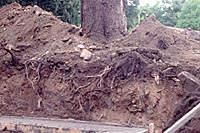 It's well-known, at least among tree care professionals, that tree roots can only grow where there's enough oxygen for them to survive. In most situations,
this means that almost all roots of even very large trees will be found within a foot or so of the soil surface - especially where heavy clay soils are common,
above.
It's well-known, at least among tree care professionals, that tree roots can only grow where there's enough oxygen for them to survive. In most situations,
this means that almost all roots of even very large trees will be found within a foot or so of the soil surface - especially where heavy clay soils are common,
above.
It's equally well-known that the roots of many trees extend far beyond the "dripline" of a tree. In fact, through tedious excavation work by researchers, it's been shown that the roots of some large trees can extend well over a hundred feet outward from their trunks!
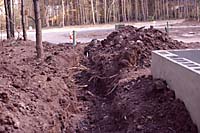 Therefore, any construction/excavation activity within fifty feet of a large tree will damage its root system to a greater or lesser extent - itís
simply unavoidable.
Therefore, any construction/excavation activity within fifty feet of a large tree will damage its root system to a greater or lesser extent - itís
simply unavoidable.
The types of damage can include excavation that cuts through
roots (remember almost all roots are within a foot of the soil
surface), stockpiling of soil and/or
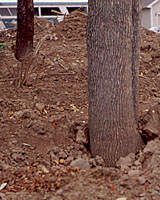 addition of "fill" that buries
roots (just like putting a plastic bag over your head, that's not a
good thing), at right, movement of bulldozers, cement trucks or other heavy
equipment that crushes shallow roots, below left, removal of bark and/or any
combination of the above.
addition of "fill" that buries
roots (just like putting a plastic bag over your head, that's not a
good thing), at right, movement of bulldozers, cement trucks or other heavy
equipment that crushes shallow roots, below left, removal of bark and/or any
combination of the above.
Obviously, the closer to the trunk the activity occurs, the more extensive the damage is likely to be, below right.
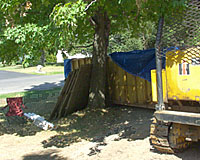 Depending upon the extent of the damage caused by construction
activity, the affected tree's canopy (leaves, stems and branches) may become less vigorous because damaged roots
canít deliver sufficient water and nutrients.
Depending upon the extent of the damage caused by construction
activity, the affected tree's canopy (leaves, stems and branches) may become less vigorous because damaged roots
canít deliver sufficient water and nutrients.
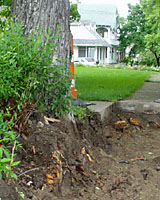 As a result, the stressed canopy loses its ability to produce and transport
sufficient plant food (simple sugars and carbohydrates produced through the process of photosynthesis) back to the root system to repair
damage caused by the construction activity.
As a result, the stressed canopy loses its ability to produce and transport
sufficient plant food (simple sugars and carbohydrates produced through the process of photosynthesis) back to the root system to repair
damage caused by the construction activity.
This vicious cycle of limited water, nutrient and photosynthate transport often results in a very gradual decline of affected trees. They often become both an eyesore and hazard long before dying ten or even fifteen years after completion of construction.
It's this scenario that often leads me to explain that homeowners building on wooded lots often pay five times for their trees;
- They first pay a premium for a wooded lot,
- They pay for the extra time it takes a contractor to work around trees to be "saved,"
- They pay an arborist for heroic measures to keep dying trees alive - even though they're not attractive and provide little shade,
- They pay someone to finally take the dead tree down - which can run to thousands of dollars if the house/deck/patio/pool was built around the tree,
- They pay a nursery/landscape contractor for a new tree that will take ten or more years (often the time spent trying to keep the original tree alive) to provide any shade or visual impact.